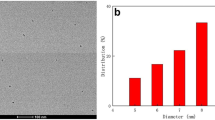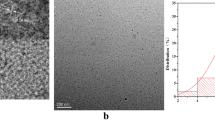Abstract
A novel and simple fluorescence Off-On system is proposed for selective pyrophosphate (PPi) sensing in an aqueous solution. The method is constructed based on the strong blue emission of carbon dots (CDs) owing to its outstanding photoluminescence and easy synthesis, which has shown exciting potential in analytical and biological field. The fluorescence of CDs can be remarkably quenched by some transition metal ions such as Cu2+, Ni2+, Mn2+ and Co2+ due to the coordination reaction between metal ions and the carboxylic groups on the surface of CDs. When PPi was introduced to CDs-metal ion system the fluorescence of CDs was recovered regularly. The increment of fluorescence intensity was proportional with the concentration of PPi in the range of 1–200 μM and correspondingly the limit of detection was calculated as 0.32 μM according to the recommendation of IUPAC as 3.29 S B/m. The possible mechanism was discussed for the detection of PPi and the quenching reaction between CDs and metal ions. Furthermore, the proposed system was successfully used to monitor the content of PPi in water samples from artificial wetland.









Similar content being viewed by others
References
Wang YH, Shen P, Li CY, Wang YY, Liu ZH (2012) Upconversion fluorescence resonance energy transfer based biosensor for ultrasensitive detection of matrix metalloproteinase-2 in blood. Anal Chem 84:1466
Michalet X, Pinaud FF, Bentolila LA et al (2005) Quantum dots for live cells, in vivo imaging, and diagnostics. Science 307:538
Kirchner C, Liedl T, Kudera S et al (2005) Cytotoxicity of colloidal CdSe and CdSe/ZnS nanoparticles. Nano Lett 5(2):331
Yu P, Wen XM, Toh Y-R, Tang J (2012) Temperature-dependent fluorescence in carbon dots. J Phys Chem C 116:25552
Wang X, Cao L, Yang ST et al (2010) Bandgap-like strong fluorescence in functionalized carbon nanoparticles. Angew Chem Int Ed 49(31):5310
Baker SN, Baker GA (2010) Luminescent carbon nanodots: emergent nanolights. Angew Chem Int Ed 49(38):6726
Xu XY, Ray R, Gu YL et al (2004) Electrophoretic analysis and purification of fluorescent single-walled carbon nanotube fragments. J Am Chem Soc 126(40):12736
Li HT, Kang ZH, Liu Y, Lee S-T (2012) Carbon nanodots: synthesis, properties and applications. J Mater Chem 22:24230
Wang YL, Anilkumar P, Cao L et al (2011) Carbon dots of different composition and surface functionalization: cytotoxicity issues relevant to fluorescence cell imaging. Exp Biol Med 236:1231
Huang J, Deming CP, Song Y, Kang XW, Zhou ZY, Chen SW (2012) Chemical analysis of surface oxygenated moieties of fluorescent carbon nanoparticles. Nanoscale 4:1010
Loh KP, Bao QL, Eda G, Chhowalla M (2010) Graphene oxide as a chemically tunable platform for optical applications. Nat Chem 2:1015
Li HL, Zhang YW, Wang L, Tian JQ, Sun XP (2011) Nucleic acid detection using carbon nanoparticles as a fluorescent sensing platform. Chem Commun 47(3):961
Liu JH, Li JS, Jiang Y, Yang S, Tan WH, Yang RH (2011) Combination of π–π stacking and electrostatic repulsion between carboxylic carbon nanoparticles and fluorescent oligonucleotides for rapid and sensitive detection of thrombin. Chem Commun 47(40):11321
Zhou L, Lin YH, Huang ZZ, Ren JS, Qu XG (2012) Carbon nanodots as fluorescence probes for rapid, sensitive, and label-free detection of Hg2+ and biothiols in complex matrices. Chem Commun 48(8):1147
Shi WB, Wang QL, Long YJ et al (2011) Carbon nanodots as peroxidase mimetics and their applications to glucose detection. Chem Commun 47:6695
Zhao HX, Liu LQ, Liu ZD, Wang Y, Zhao XJ, Huang CZ (2011) Highly selective detection of phosphate in very complicated matrixes with an off–on fluorescent probe of europium-adjusted carbon dots. Chem Commun 47:2604
Dong YQ, Li GL, Zhou NN, Wang RX, Chi YW, Chen GN (2012) Graphene quantum dot as a green and facile sensor for free chlorine in drinking water. Anal Chem 84:8378
Lin Z, Xue W, Chen H, Lin JM (2011) Peroxynitrous-acid-induced chemiluminescence of fluorescent carbon dots for nitrite sensing. Anal Chem 83(21):8245
Li HL, Zhai JF, Sun XP (2011) Sensitive and selective detection of silver(I) ion in aqueous solution using carbon nanoparticles as a cheap, effective fluorescent sensing platform. Langmuir 27(8):4305
Li HL, Zhai JF, Tian JQ, Luo YL, Sun XP (2011) Carbon nanoparticle for highly sensitive and selective fluorescent detection of mercury(II) ion in aqueous. Biosens Bioelectron 26:4656
Huebner PWA, Milburn RM (1980) Hydrolysis of pyrophosphate to orthophosphate promoted by cobalt(III). Evidence for the role of polynuclear species. Inorg Chem 19(5):1267
Terkeltaub R (2006) Physiologic and pathologic functions of the NPP nucleotide pyrophosphatase/phosphodiesterase family focusing on NPP1 in calcification. Purinergic Signalling 2:371
Ronaghi M, Uhlén M, Nyrén P (1998) A sequencing method based on real-time pyrophosphate. Science 281(5375):363
Kim SK, Lee DH, Hong J-I, Yoon J (2009) Chemosensors for pyrophosphate. Acc Chem Res 42(1):23
Kruppa M, König B (2006) Reversible coordinative bonds in molecular recognition. Chem Rev 106(9):3520
Mikata Y, Ugai A, Ohnishi R, Konno H (2013) Quantitative fluorescent detection of pyrophosphate with quinoline-ligated dinuclear zinc complexes. Inorg Chem 52(18):10223
Bhowmik S, Ghosh BN, Marjomäki V, Rissanen K (2014) Nanomolar pyrophosphate detection in water and in a self-assembled hydrogel of a simple terpyridine-Zn2+ complex. J Am Chem Soc 136(15):5543
Credo GM, Su X, Wu K et al (2012) Label-free electrical detection of pyrophosphate generated from DNA polymerase reactions on field-effect devices. Analyst 137(6):1351
Villamil-Ramosa R, Yatsimirsky AK (2011) Selective fluorometric detection of pyrophosphate by interaction with alizarin red S–dimethyltin(IV) complex. Chem Commun 47:2694
Fabbrizzi L, Marcotte N, Stomeo F, Taglietti A (2002) Pyrophosphate detection in water by fluorescence competition assays: inducing selectivity through the choice of the indicator. Angew Chem Int Ed 41(20):3811
Ganjali MR, Hosseini M, Aboufazeli F, Faridbod F, Goldooz H, Badiei AR (2012) A highly selective fluorescent probe for pyrophosphate detection in aqueous solutions. Luminescence 27(1):20
Su X, Zhang C, **ao XJ, Xu AQ, Xu ZD, Zhao MP (2013) A kinetic method for expeditious detection of pyrophosphate anions at nanomolar concentrations based on a nucleic acid fluorescent sensor. Chem Commun 49(8):798
Hanshaw RG, Hilkert SM, Jiang H, Smith BD (2004) An indicator displacement system for fluorescent detection of phosphate oxyanions under physiological conditions. Tetrahedron Lett 45(47):8721
Liu DJ, Credo GM, Su X et al (2011) Surface immobilizable chelator for label-free electrical detection of pyrophosphate. Chem Commun 47:8310
Ray SC, Saha A, Jana NR, Sarkar R (2009) Fluorescent carbon nanoparticles: synthesis, characterization, and bioimaging application. J Phys Chem C 113:18546
Tian L, Ghosh D, Chen W, Pradhan S, Chang X, Chen S (2009) Nanosized carbon particles from natural gas soot. Chem Mater 21:2803
Lu J, Yang JX, Wang J, Lim A, Wang S, Loh KP (2009) One-pot synthesis of fluorescent carbon nanoribbons, nanoparticles, and graphene by the exfoliation of graphite in ionic liquids. ACS Nano 3:2367
Hu SL, Niu KY, Sun J, Yang J, Zhao NQ, Du XW (2009) One-step synthesis of fluorescent carbon nanoparticles by laser irradiation. J Mater Chem 19:484
Peng H, Travas-Sejdic J (2009) Simple aqueous solution route to luminescent carbogenic dots from carbohydrates. Chem Mater 21:5563
Conry RR (2006) Copper: inorganic & coordination chemistry, Wiley. Encycl Inorg Chem
Hu CG, **ao Y, Zhao Y et al (2013) Highly nitrogen-doped carbon capsules: scalable preparation and high-performance applications in fuel cells and lithium ion batteries. Nanoscale 5(7):2726
Zheng HZ, Wang QL, Long YJ, Zhang HJ, Huang XX, Zhu R (2011) Enhancing the luminescence of carbon dots with a reduction pathway. Chem Commun 47:10650
Zhu SJ, Meng QN, Wang L et al (2013) Highly photoluminescent carbon dots for multicolor patterning, sensors and bioimaging. Angew Chem Int Ed 52:3953
Shi QQ, Li YH, Xu Y et al (2014) High-yield and high-solubility nitrogen-doped carbon dots: formation, fluorescence mechanism and imaging application. RSC Adv 4:1563
Fan RJ, Sun Q, Zhang L, Zhang Y, Lu AH (2014) Photoluminescent carbon dots directly derived from polyethylene glycol and their application for cellular imaging. Carbon 71:87
Wee SS, Ng YH, Ng SM (2013) Synthesis of fluorescent carbon dots via simple acid hydrolysis of bovine serum albumin and its potential as sensitive sensing probe for lead (II) ions. Talanta 116:71
Liu JM, Lin LP, Wang XX et al (2012) Highly selective and sensitive detection of Cu2+ with lysine enhancing bovine serum albumin modified-carbon dots fluorescent probe. Analyst 137:2637
Ikotun OF, Marino N, Kruger PE, Julve M, Doyle RP (2010) Coordination complexes incorporating pyrophosphate: structural overview and exploration of their diverse magnetic, catalytic and biological properties. Coord Chem Rev 254:890
Jiang H, Zhao XY, Schanze KS (2006) Amplified fluorescence quenching of a conjugated polyelectrolyte mediated by Ca2+. Langmuir 22(13):5541
Mauricio SM, Holfkens J, Gehlen MH (2008) Static and dynamic biomolecular fluorescence quenching of porphyrin dendrimers in solution. J Fluoresc 18(5):821
Htun T (2003) Excited-state proton transfer in nonaqueous solvent. J Fluoresc 13:323
Lackowicz JR (1999) Principles of fluorescence spectroscopy, 2nd edn. Kluwer Academic/Plenum Publishers, New York
Acknowledgments
This work was financially supported by Natural Science Foundation of China for funding (21005036, 20875042, 21075058, and 21127006), Natural Science Foundation (ZR2014BQ017, 2013SJGZ07, and JQ201106) of Shandong Province and doctoral research fund of Liaocheng University.
Author information
Authors and Affiliations
Corresponding authors
Rights and permissions
About this article
Cite this article
Yue, Q., Hou, Y., Yue, S. et al. Construction of an Off-On Fluorescence System Based on Carbon Dots for Trace Pyrophosphate Sensing. J Fluoresc 25, 585–594 (2015). https://doi.org/10.1007/s10895-015-1538-9
Received:
Accepted:
Published:
Issue Date:
DOI: https://doi.org/10.1007/s10895-015-1538-9




